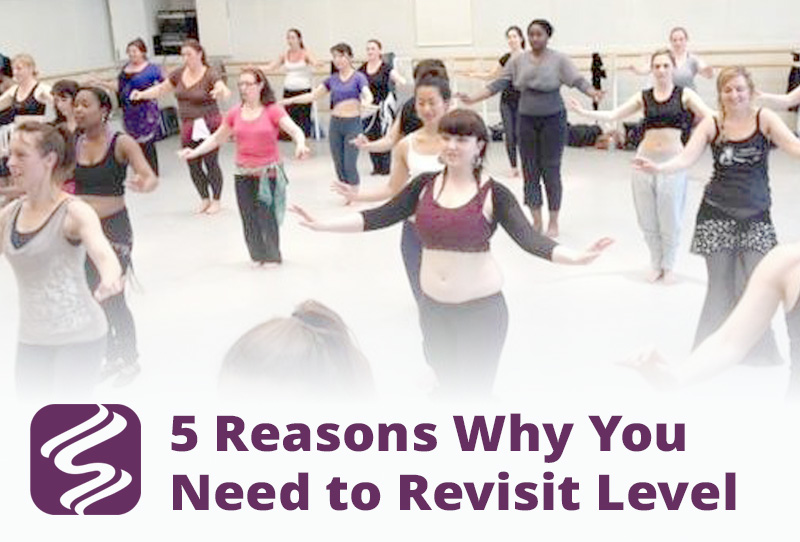
Today, belly dance certification is everywhere. But when Suhaila began her program back in the 1990s, certification was a radical and controversial idea. But is there a reason to pursue Salimpour certification?
Long time dancers in the field argued that belly dance is a folk dance, and that certification and testing would remove the creativity and personalization that are so essential in this form. Others felt that standardized terminology would fossilize belly dance, preventing it from developing and changing with the times.
Obviously, we would argue otherwise. After over 20 years of offering a comprehensive and rigorous certification program, we know that it’s not hindering our students creativity, sterilizing their dancing, or removing emotional expression.
But we still get asked:
Why should I certify?
1. Technique
Of course, when someone mentions the Salimpour School, one of the first things you might think of is drilling. We are known for our physically-demanding classes, for sweating and sore muscles. But it’s not hard work for hard work’s sake. It makes even the most challenging movements habitual. And we need that muscle memory for when we’re making dances, whether it be through choreography or improvisation. Technique is not something to be shown off, but something to be taken for granted.
And our students often remark that when they attend other belly dance workshops (and other dance classes in general) they can pick up the nuances and the essence of that instructor without worrying about how to do a movement. They are more free to observe and absorb that instructor’s personal flair, and they get more out of the opportunities they have to study with other dance instructors.
From a strong technical foundation, we learn our bodies. We learn its limitations, its strengths, and its vulnerabilities. From there, we can then take better care of our physical selves.
2. Resiliency and Achievement
While belly dance as a discipline does not require testing or levels or certification or anything of the like, the Salimpour program is famous for being the first tiered certification program in belly dance. Born out of a frustration that belly dance lacks professional standards, the Salimpour School gives us benchmarks by which to achieve personal technical and creative goals. We are pushed beyond what we might never believe possible if we were left to our own devices.
Beginning in Level 1, when you pass, you feel like you truly earned that certificate. Not everyone passes a test the first time. We do not award participation ribbons. These programs are not easy. Even our Level 1 is more difficult than most other belly dance programs out there.
But they’re not difficult for the sake of being difficult, but they presume that we are working towards a kind of virtuosity. In higher levels, the weeklong workshops require dancers to complete homework in the evenings, sometimes leading to nights of not enough sleep. We are required to hand something in, anything, as long as it fulfills the expectations of the assignment. We learn that perfect is the enemy of done.
And many of us have found that the resiliency and tenacity that we learn while pulling these all-nighters filters into our lives outside of the studio. It’s in these moments of exhaustion that we learn to surrender to the process and accept that whatever we present, as long as we present something, is absolutely good enough.
As the Georgia Salimpour Collective says, we know how to “struggle properly.”
3. Creativity, Individuality, and Personal Authenticity
One of the most common criticisms of belly dance certification is that it will dampen a dancer’s creativity and individuality. Indeed, the opposite is true.
When you have a strong technical foundation, rooted in history, context, and emotional expression, in addition to musical training, your personal voice can really shine through. You can move beyond imitating other dancers and exploring movement combinations and pathways that express your own emotions and musical interpretation.
Our students truly begin to blossom and get in touch with their true nature in the higher levels. They discover and develop what makes them tick as artists and as human beings.
4. Real Belly Dance History
When our certification programs first started, it was difficult to find a comprehensive history of belly dance. Indeed, there are many tales of it being an “ancient” dance of goddess worship. But the Salimpour School has created a curriculum that eschews the “wish-tory” of belly dance in favor of more concrete documentation.
And knowledge of belly dance history also means understanding the legacy of the Salimpour School. In fact, when we republished the articles that Jamila wrote for Habibi magazine, we realized that we needed to create a companion volume to contextualize her perspectives and the time in which she was writing. Dance studies had hardly started when Jamila was teaching, but today we have so many more resources available to us with so much more research from which to draw.
We’re proud to focus on the reality of belly dance, both in its countries of origin and around the world.
5. Musical and Cultural Responsibility
Suhaila urges all students of the school, regardless of what level they’re in, to listen to Arabic music. Within Arabic music are so many of the nuances of Arab culture, from its complex maqam system, its layered poetry, to perceptions and expressions of love and sorrow.
In Levels 3 and 4 of both the Jamila Salimpour and Suhaila Salimpour Formats, it becomes clear that physicalization and embodiment of the sentiment of the music is the dancer’s paramount responsibility. In these levels, too, we receive guidance on how to work with live musicians, including the norms and etiquette expected of us by the musicians and the audience.
From the music, we gain a deeper embodied understanding of stylization. Different music should evoke different physical responses in our body. We learn that the rhythms reveal a song’s origin, and from that, we can better suit our movements. And that movement becomes instinctual through our hours of physical training.
We do not dance in a vacuum, a fantasy land where our actions have no consequences. No, indeed, the very opposite is true. Dancers in the Salimpour School learn very quickly about the realities that professional dancers in the Middle East face, as well as the context of all of the work that we perform an create… even the faux-loric work presented in Bal Anat.
6. A Standard Language
The Salimpour School’s system of belly dance movement names, downbeats, and timings make it possible for us to transmit our dances to anyone else in the world who knows this language. We can verbalize or write our movements quickly and clearly. Just take a look at our Twitter Drills or our Wednesday drill challenges on Instagram.
And it’s easy to learn. All dancers who pass Suhaila Format Level 1 have demonstrated that they understand this unique and decidedly simple dance nomenclature.
7. Our Global Community
After over 70 years, we’ve created a global community of dancers. And we have licensed instructors all over the world, from California to Cairo.
Every Salimpour workshop, either with Suhaila herself or with any of our instructors, is like a big friend reunion… but even better, because we have shared interests and goals. The summer workshops remind me of how powerful our community is, and how important it is that we have connections around the world.
And now, with our Salimpour Collectives, dancers in the program can study, grow, and perform with like-minded students, showing their work as they go.
Still not convinced? Sign up for an online class website subscription, which has hundreds of classes on technique, stylization, music, history, anatomy, and choreographies. Or take one of the 6-week Level 1 online courses. Or take a workshop or class with our authorized instructors.
Whether you only try Level 1 or want to complete the entire program, there is a place in the school for you.
You’ll find that we’re passionate about what we do, and that the technical foundations will serve you well in whatever style you pursue.
The original blog was published in the Salimpour School blog on 20 Feb 2020.
